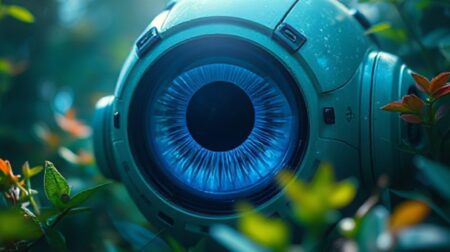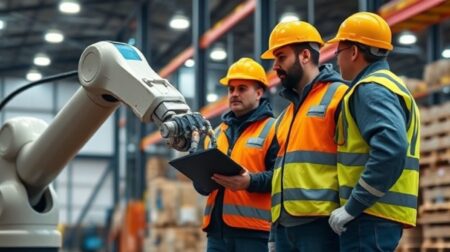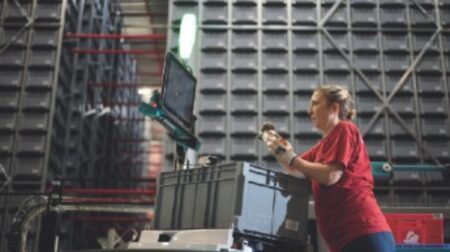John Thornton asks four experts to share insights on what the future of manufacturing automation could look like…
The industrial robot has been the stalwart of automated manufacturing for the past 40 years. But with consumer demand driving greater variety and frequency of new products, coupled with greater scarcity and cost of raw materials and energy, is it right to challenge how fit for purpose today’s robots are for the future factory?
Here, Simon Carr, general manager at Industry Forum; Paul Baird, chief technical security officer UK at Qualys; Mark Gray, country manager for UK & Ireland at Universal Robots; and Neil Ballinger, head of EMEA at EU Automation, highlight some of the emerging factors that are driving changes to manufacturing automation and explore how a data-driven approach can yield the performance and flexibility required from industrial robots to meet demands of the smart factory.
Q: How is manufacturing changing and what does this mean for automation?
Simon Carr: Within some manufacturers, there is so much going on with Covid, Brexit and supply change shortages that contemplating a fundamental shift in operations technology would be the last straw now. In some instances, there just won’t be the bandwidth to take it seriously. On the other hand, large corporates will see big data and IIOT etc. as a fabulous opportunity to differentiate. We’re seeing a clear dividing of the pack.
Neil Ballinger: The events of the past two years have amplified the need of businesses across every industry for automation technologies to help them respond to global phenomena and stay competitive. In terms of automation, we have seen a surge in the popularity of solutions that facilitate social distancing on the factory floor — from wearable devices to modular production stations that can be easily rearranged to increase spacing between workers.
Paul Baird: The whole world of manufacturing has changed due to the impact of Covid-19 with supply shortages and unscheduled factory shutdowns – this was caused by a lack of staff with the right skills, as well as macro trends like country lockdowns affecting how quickly components or goods could be produced and shipped. Demand for certain products has increased the need for an agile factory, which can only come with automation and AI. There are clear indications that implementing more automation can fix some of the problems but not all of them.
Mark Gray: The biggest problem we are seeing is labour shortages, first because of Brexit uncertainty and more so now with Covid affecting staff numbers on the shop floor. As well as this, manufacturing is an industry with an aging workforce. We spoke to a company who had an average age of 56, so in 10 years they’re going to have a real problem if they can’t find new engineers, or they haven’t found ways to automate. The landscape we’re going in to is very different and even if many things go back to normal, automation has been adopted to a very high scale to fix historical problems. It’s essential that companies change the way they manufacture in the next 12-18 months, or they risk being left behind, especially if they want to be competitive in the global marketplace.
Q: What are the limitations of current industrial robots and how do these impact smart factories?
SC: The current generation of robots still need humans to feed them with the information and to validate that they are doing things correctly. Human intervention does carry risks: the burden of time, errors and machines always end up waiting for humans. The next generation of robots will be able to teach themselves certain things, diagnose their conditions and act accordingly, essentially doing away with humans.
PB: The biggest limitation is age. A lot of the manufacturing floor environments in place across the globe are full of technology assets that might be fit for purpose, but the rest of the IT world would regard them as relics. These operational technology assets and software can be in place for years, even decades. They are also often out of date – either they are too expensive to replace based on the amount of capital needed, or the amount of downtime required to update or replace them would severely impact the business.
MG: Many industrial robots are designed for individual stations. They are effective for only one task and, while useful, it limits their flexibility as we look towards Industry 4.0. Smart factories need to be flexible and efficient. When the scenario changes, for example market demand increases for something your robot cannot make or staff have to isolate urgently, you need to have automation that can adapt quickly with reduced programming time.
Q: How are sensors and a data-driven approach increasing automation flexibility and performance?
SC: We are seeing an evolvement of today’s robots, using a collaboration of sensors, IIOT and AI to become much smarter and deliver a raft of benefits. An application we’re seeing many manufacturers move toward is replacing manual maintenance checks of robots with sensor-based condition monitoring, in the ‘body-in-white’ stage of an automotive production, for example. Robots undertaking spot-welding can now also monitor the condition of welding tips. Sensors can detect when they have deteriorated to the exact point of replacement and another robot can then change them. A lot of data can be generated to predict component life, measuring exactly where in its lifecycle a part is and when failure will occur. We see IIOT as doing the monitoring and, when talking to each other, AI crunches the data, processing it to provide something meaningful.
PB: Sensors create data that can be gathered and used, telling you how your assets are performing and how efficient your processes are. Using this data, you can then get more insight into how your production levels match demand coming in. This data-driven approach is part of how companies have to compete with each other in the market. They want to use data more effectively, and they want that data available faster. This means that manufacturers are more likely to implement sensors on their assets, connect those sensors and assets up, and collect that data in real time.
MG: Connected manufacturing between different devices can only lead to better production in the future. You are gathering data all the time, meaning that you can map out your own processes to accurately measure costs, productivity and scrap. Robots can add a lot of value within manufacturing without doing anything particularly ‘smart’. For example, just having them load and unload parts from a CNC machine can drive a rapid return on investment if it frees up employees to focus on other activities.
Q: What are the most critical emerging factors driving changes in manufacturing automation?
SC: Demands in the supply chain and customer requirements are the most critical emerging factors driving changes to manufacturing automation. Customers want ever increasing diversity and choice, and as a result, supply chains want to optimise inventory and the logistics of moving and holding them. The proliferation is driving the need. Behind the ‘Amazon effect’ is the whole supply chain feeding the animal as well the type of automation and the speed of transactions.
PB: Most established businesses are struggling to invest in Industry 4.0 approaches today. It can require capital expenditure that is harder to achieve due to the pandemic and global economic trends that followed. That being said, there is a need for more control and consistency and that can only be achieved with automation. Businesses need to consider automation within their own environment as well as the supply chain, which can be the weakest link and where you have no control.
MG: What we’re seeing more of in the last 12 months is a change in company culture and manufacturers being open to new techniques. Global players are in contact now about getting a cobot strategy across all of their sites to increase productivity where there is a lack of labour and social distancing on the shop floor. With a backlog of orders to fulfil it’s important to put steps in place now to increase output and make costs of manufacturing more predictable.
Q: What roles will AI and machine learning play in the factory of the future and what benefits will these technologies bring?
SC: IOT generates the data and AI processes that data to provide meaningful, actionable information. The question is to what extent is that fed to humans and to the equipment, so you can have autonomous behaviours. Having masses of data available doesn’t mean anything if management do not know what to do with it. Manufacturers will fail to make any meaningful improvement to their competitiveness if they are missing a firm foundation upon which all subsequent change can be built. This means ensuring that current production operation systems and machinery are working as smoothly as they can be before introducing AI and too many digital tools.
PB: This is a bit of a double-edged sword. The more automation and AI you bring onto the factory floor, the more benefits you can achieve. For example, you can get more agility to support demand, and measurable consistent output means output planning is easier and more accurate. At the same time, the increase in operational technology cyber-attacks is a risk. Bringing all your data together will mean that you have all your eggs in one basket, which can then put your organisation in a bad situation at the hands of threat actors if they can successfully attack you. Implementing connected OT assets as part of a smart factory means that organisations must invest in better cyber security coverage of that manufacturing floor as they increase AI and automation.
Q: What impact will increased automation in manufacturing have on personnel?
SC: This will be more about evolution than revolution. Roles will change. There will still be areas of conventional technology as well as the super intelligent robots. Economies of scale need to be considered – for some type of products and processes, it won’t made financial sense to have automation. Things will become more flexible. Let’s not forget you still need volume to warrant the investment in automating something. There will always need to be a manual element.
NB: While some may think that these technologies will eliminate human jobs, I think what we’re in fact noticing is that more jobs are being created. I believe increased automation will bridge the communication between human workers and robots and create combined work environments. We’ll witness new job functions like a robot team coordinator, whose role would be to supervise the robot performance and provide feedback to programmers to optimise robot value, while enabling a collaborative human-robot working environment.
PB: When you increase your use of automation, it does mean that you need fewer resources to cover a specific task. At the same time, you will find that this will give people the opportunity to retrain around more high value work. As an example, automation takes away those manual handling tasks, allowing people to retrain in other areas such as maintenance of the automation system. So, the result of deploying automation should be an opportunity to rebalance your workforce and create more value overall. Staff should see opportunities to improve their positions and enjoy their work more.
MG: You’re never going to get rid of people, they’re any business’s single greatest asset. There are hundreds of skills that a robot doesn’t have. It doesn’t have intuition; it can’t make decisions; those are human attributes. Human skill is the most valuable resource for any manufacturing business and that must be used sparingly and to your advantage. Using a robot as a tool to take over dull, dirty and dangerous jobs doesn’t put people out of work, it puts people in jobs where they are giving the most value. I‘d argue it’s actually a lack of robotics and automation that harms job prospects as those that don’t move with the times are quickly out-competed on the global stage.
This article originally appeared in the January 2022 issue of Robotics & Innovation Magazine








